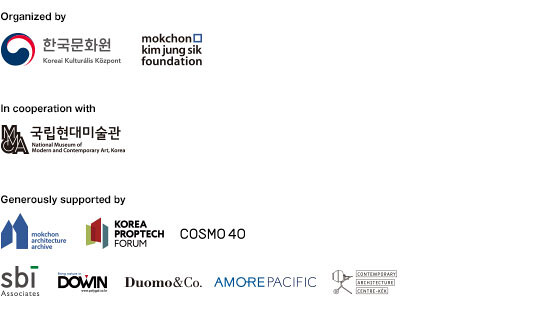November 11, 2019–February 28, 2020
Budapest
1023 Budapest Frankel Leó út 30-34
Hungary
In commemorating the 30-year anniversary of the opening of Hungary-Korea relations, the Korean Cultural Center Hungary and the Mokchon Kim Jung Sik Foundation, in collaboration with the National Museum of Modern and Contemporary Art, Korea (MMCA) present Contemporary Korean Architecture, Cosmopolitan Look 1989-2019, a retrospective centered on 30 architectural projects of Korea’s past 30 years. Cosmopolitan Look begins with a Prologue, an introduction to the key events of the last three decades and the theoretical outlook of the exhibition. It then moves through the series of projects in a mixture of thematic groups and periodic flow. The exhibition closes with an Epilogue that introduces new digital platforms related to architectural design, urban planning, and real estate development.
Each project leads a narrative not only through Korea but through the web of its connections to the world. The ambition of the selection is to show projects with the highest architectural quality but also, and perhaps more importantly, projects that tell the story of the changing nature of Korea and the world. From the way we work, our manner of remembrance, to the way we transform existing landscapes, each and every project tells a specific yet universal story. How does society, through its architectural projects, respond to the explosive demand for housing? How does it situate itself in an open society of mass participation? How does it adjust to changing conditions of work and layout? How does its role change with the increasing dominance of online space? etc. Cosmopolitan Look presents 30 projects in their spatial and temporal context, communicating their status within Korean society and their relevance within a global society. Cosmopolitan Look underscores the idea of the project, rather than the built work, as the basis of its selection. Dictionaries define a project as individual and collective enterprises, work and activity that have intention and purpose. Basing the exhibition on the project, we gain wider leverage to connect architecture to a complex of ideas, agents, practices, and conditions. Projects may fail or succeed, but because of a project’s sense of purpose, their story can all be told within the larger historical fabric.
Certainly not the first exhibition that pursues an overview of contemporary architecture in Korea, Cosmopolitan Look distinguishes itself by showing its evolution as a trans-national phenomenon. Cosmopolitan Look goes beyond this Korea-centric perspective. Its trans-nationalism is not a utopian view that the nation-state has become irrelevant. It is rather a realist approach that assumes relations that go beyond the national interest must be part of an understanding and engagement with architecture and society. We argue that identity is not a fixed entity, that architecture is not just a set of pre-determined monuments but a vast and dynamic agglomeration of ideas and practices. Following the spirit of 1989, we look to the past and to a future that break down conventional barriers.
Chief Curator Pai Hyungmin
Curators Choi Won-joon, Park Junghyun, Chung Dahyoung
Assistant Curators Kim Green, Jung Sungkyu
Exhibition Design Kim Yongju
Graphic Design Hongbaksa
Participating Architects and Artists Beak Yunsuk, Chang Yongsoon, Cho Byoung-soo, Cho Minsuk, Cho Sung Hyeon, Cho Sungkeun, Choi Moongyu, Choi Wook, Choi Yunhee, Christopher Felger, Chung Guyon, David Chipperfield, Florian Beigel, Ha Jinu, Hwang Doojin, Itami Jun, Jason Sung Woo Ahn, Jeon Jinhong, Jo Janghee, Joh Sungyong, Jong Soung Kimm, Jung Su-Jin, Jung Youngsun, Kang Yerin, Ken Sungjin Min, Kim Chanjoong, Kim Incheurl, Kim Jong Kyu, Kim Taekbin, Kim Young Joon, Kyu Sung Woo, Lee Chihoon, Lee Heunjoo, Lee Jeonghoon, Lee Sangkoo, Mihn Hyun Jun, Min Hyun Sik, Patrik Schumacher, Philip Christou, Seo Seung-mo, Seung H-Sang, Simon Seok-hoon Bae, Texu Lee, Won Youmin, Yang Soo-in, Yoo Ehwa, Yoo Kerl, Yoon Seung-Joong, Zaha Hadid


